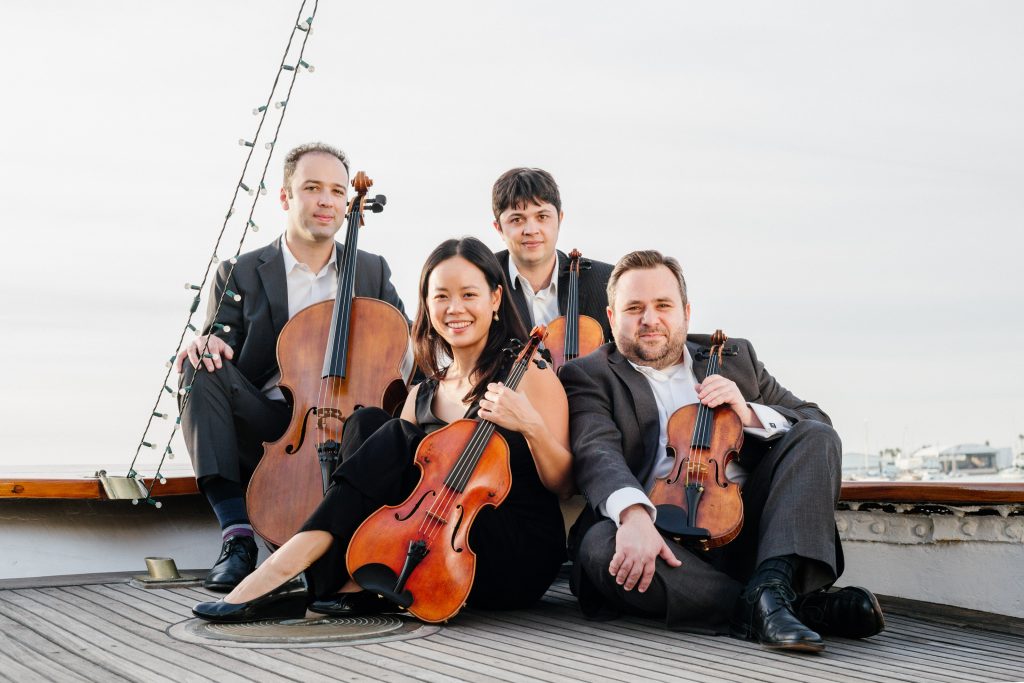Haydn and Adès Sail with Hausmann Quartet at the Maritime Museum
Continuing its admirable Haydn Voyages series at the Maritime Museum of San Diego, the Hausmann Quartet offered a cannily varied program Sunday, May 28. Contrasting the series’ requisite Haydn string quartet on each half, Hausmann included works by Antonín Dvořák, Anton Webern and the contemporary British composer Thomas Adès.

Hausmann Quartet: (from left) Alex Greenbaum, Angela Choong, Isaac Allen, Bram Goldstein [photo (c) Samantha Zauscher]
I thought Dvořák’s two contrasting “Cypress” offerings were Hausmann’s strongest suit on this program. These short pieces required a fuller, more rounded sonority from the quartet, which they supplied with alacrity, and they played the composer’s readily communicated emotional states—plaintive remorse in “Cypress” No. 2 and frothy satisfaction in “Cypress” No. 11–with enviable candor.
Webern’s “Langsamer Satz” (“Slow Piece”), written in 1905 before his studies with Arnold Schoenberg took his style in a completely different direction, moves in the creative tension of a glistening surface that barely conceals the restless chromatic harmonic tension beneath it. Hearing Hausmann perform it with such clear focus and exquisite intonation brought to mind Webern’s “Im Sommerwind”—written a year earlier in similar style—that the San Diego Symphony performed so splendidly earlier this month under guest conductor Matthias Pintscher. Perhaps the next time some musical friend makes a disparaging comment about Webern’s austere and unfriendly 12-tone music, you might suggest they audition these two early works of the Webern canon.
This marked the second time this season I have heard Hausmann play the Adès “Arcadiana,” Op. 12, from 1994. And each time, it gives a different impression, a sign either of a subtly written piece or of the critic’s wandering attention. The composer teases us with Venezia notturno, the picture postcard opening movement: over eerie, gossamer rocking motifs, the viola intones a slightly distorted theme, played with accomplished ease by Angela Choong. In spite of poetic titles for the remaining three movements, Adès avoids obvious pictorial suggestion in favor of clever abstraction: turbulent, densely layered textures in the second movement and short, flickering motifs in the third, surrounded by pizzicato clusters. In the final movement, cellist Alex Greenbam deftly maneuvered the twisting main subject through a maze of wispy scratches from the other strings, until the music simply vanished.
Hausmann is owning this engaging piece, and I hope they perform it frequently. It has much to give audiences on multiple hearings!
Haydn’s String Quartet in F Minor, Op. 20, No. 5, like his symphonic works in minor keys, displays rich, varied harmonic adventure, although Hausmann did not bring this out to the extent more aggressive string quartets do, and their dynamic range remained on the lighter side throughout the string quartet. First violinist Isaac Allen pleasured us with effusively ornamented melody in the Andante, delivered in his usual dulcet tone. The clean articulation of the fugal Finale completed this quartet with just the right flair.
Because the Sunday afternoon San Diego Symphony concert at the Jacobs Music Center lasted longer than usual, and it took more than a few minutes to get across downtown to the Maritime Museum, I did not hear enough of the program opening Haydn String Quartet in G Major, Op. 17, No. 5, to write about it.
[themify_box style=”shadow” ]
This concert by the Hausmann Quartet was presented at the Maritime Museum of San Diego on Sunday, May 28, 2017, at 4:00 p.m. The next program in this Haydn Voyages series is slated for September 17, 2017, in the same venue.
[/themify_box]

Ken Herman, a classically trained pianist and organist, has covered music for the San Diego Union, the Los Angeles Times’ San Diego Edition, and for sandiego.com. He has won numerous awards, including first place for Live Performance and Opera Reviews in the 2017, the 2018, and the 2019 Excellence in Journalism Awards competition held by the San Diego Press Club. A Chicago native, he came to San Diego to pursue a graduate degree and stayed.Read more…
